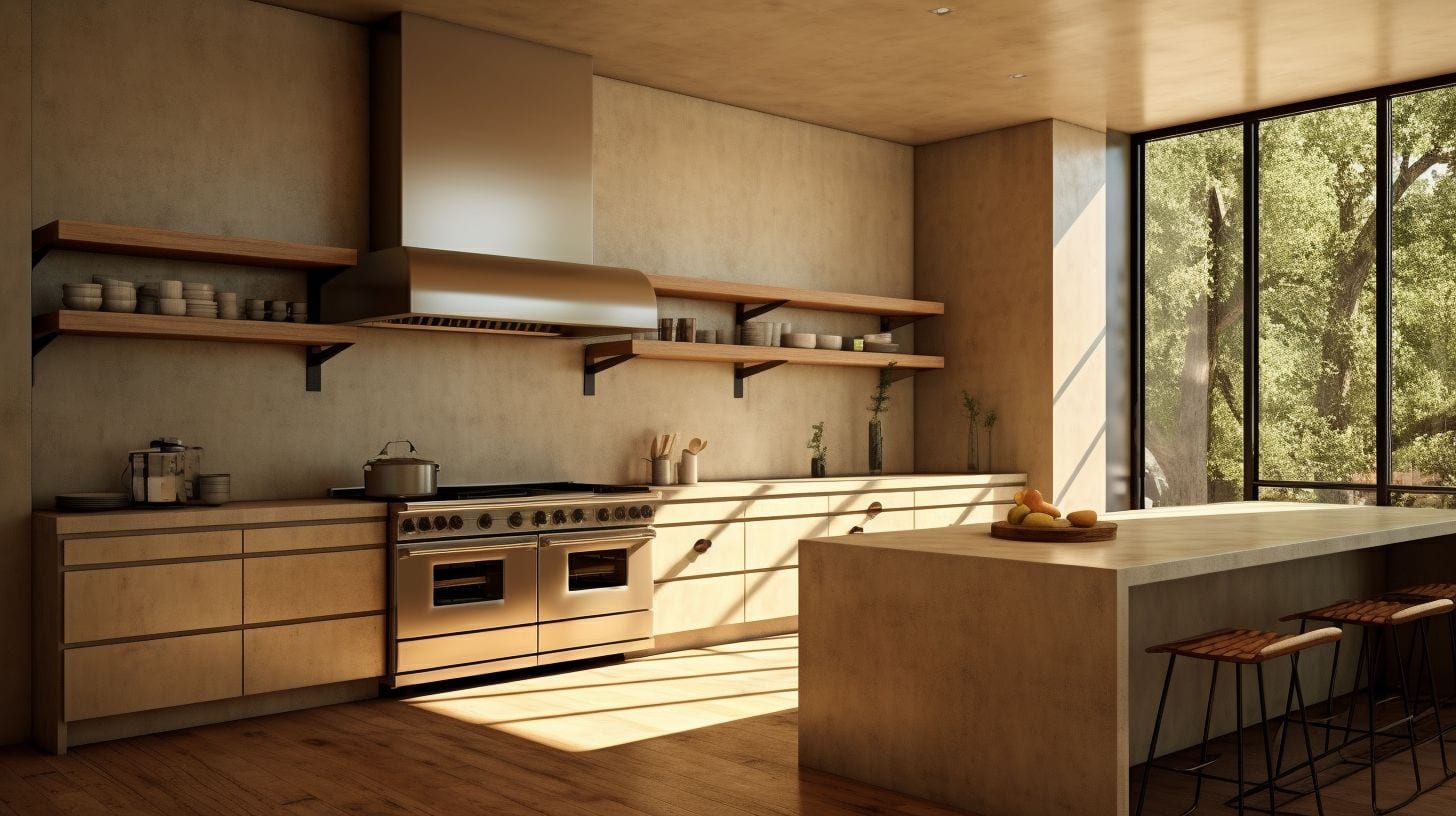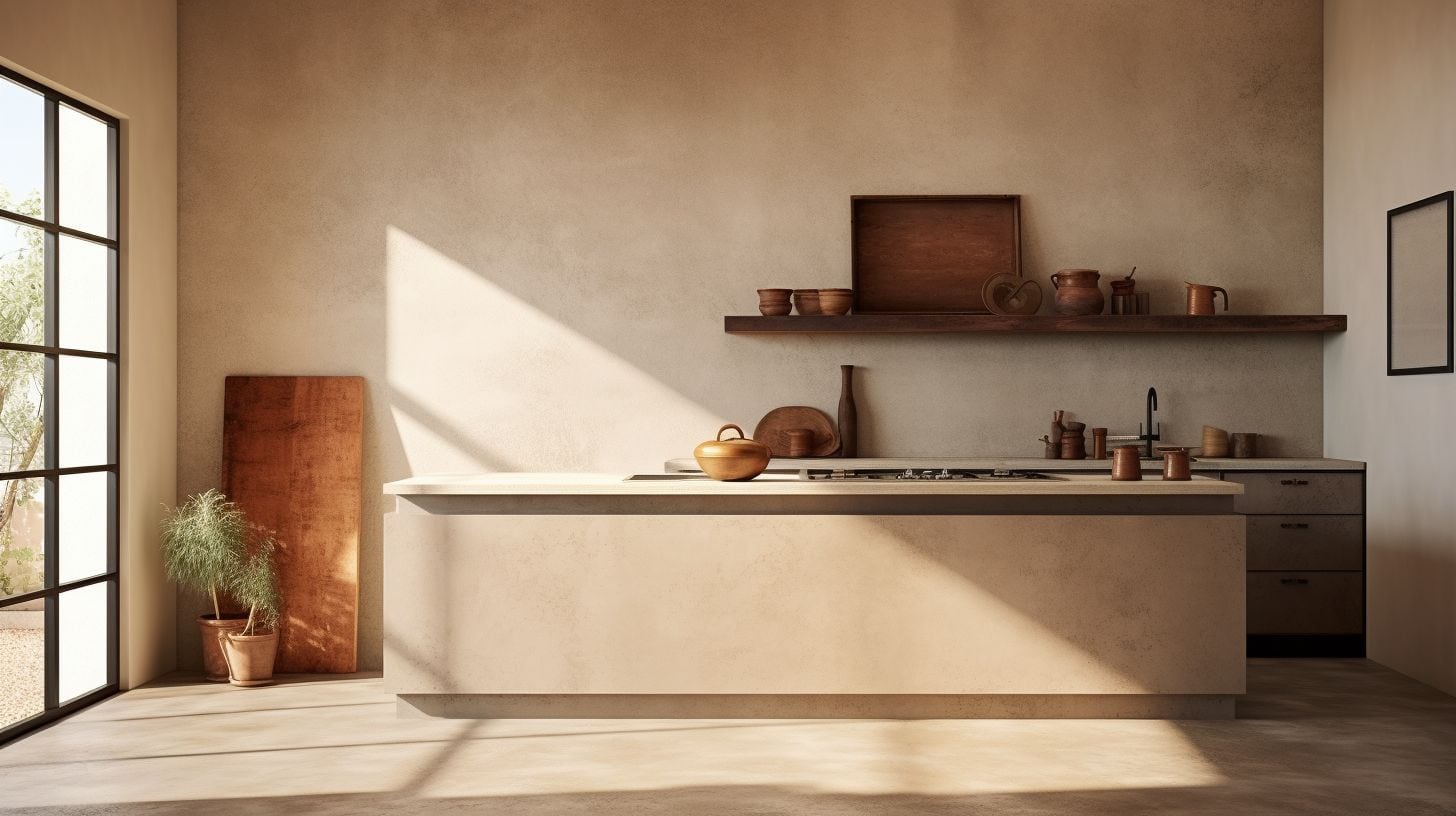Tadelakt: The Art of Moroccan Plaster
Tadelakt, a traditional Moroccan plastering technique, is renowned for its smooth, polished finish and waterproof qualities. Originating in the historic city of Marrakech, Tadelakt has been used for centuries to decorate the palaces, hammams, and riads of Morocco. Its unique properties and aesthetic appeal have made it a sought-after choice for modern interior and exterior designs around the world.
A Timeless Tradition with Modern Appeal
Rooted in the rich cultural heritage of Morocco, Tadelakt combines the artistry of ancient plastering techniques with the practicality of contemporary applications. This versatile plaster not only enhances the visual appeal of spaces but also offers durable and environmentally friendly solutions for various surfaces.
In this article, we will explore the composition and unique features of Tadelakt, delve into the application techniques, and discuss its diverse uses in both residential and commercial settings.

Composition and Unique Features
Traditional Ingredients
Lime Sourced from Moroccan Quarries
The primary ingredient in Tadelakt is lime, specifically lime sourced from the quarries in the Marrakech region of Morocco. This lime, when mixed with water, creates a pliable paste that can be applied to various surfaces. The quality and properties of this lime are essential to achieving the smooth, polished finish that Tadelakt is known for.
Marble Dust and Natural Soap
In addition to lime, Tadelakt incorporates marble dust to enhance its texture and durability. The marble dust provides a subtle sheen and helps achieve the plaster’s characteristic smoothness. Natural soap, typically black olive oil soap, is used during the polishing process to impart the waterproof qualities that make Tadelakt suitable for wet environments. The soap reacts with the lime, creating a calcium soap that seals the surface.
Natural Pigments for Colour Variation
Natural pigments are added to Tadelakt to create a range of colours, from earthy tones to vibrant hues. These pigments are derived from minerals and plants, ensuring that the plaster retains its natural and eco-friendly properties. The use of natural pigments allows for a variety of custom finishes, enhancing the versatility of Tadelakt in different design contexts.
Unique Features of Tadelakt
Smooth, Waterproof Finish
One of the most distinctive features of Tadelakt is its smooth, polished finish, which resembles natural stone or marble. This finish is not only visually appealing but also highly practical, as the application of natural soap renders the surface waterproof. This makes Tadelakt an ideal choice for bathrooms, kitchens, and other areas exposed to moisture.
Natural Antibacterial Properties
Tadelakt’s lime-based composition gives it natural antibacterial properties, making it a hygienic option for surfaces that require regular cleaning and sanitation. The smooth, sealed finish also prevents the growth of mold and mildew, contributing to a healthier indoor environment.
Environmental Benefits
Tadelakt is an environmentally friendly building material. Its ingredients are natural and sustainably sourced, and the plaster itself is biodegradable. The use of Tadelakt can contribute to sustainable building practices, reducing the environmental impact of construction and renovation projects.
Application Techniques
Surface Preparation
Cleaning and Priming the Surface
Proper surface preparation is essential for achieving a flawless Tadelakt finish. Start by thoroughly cleaning the surface to remove any dust, grease, or old paint. The surface must be smooth, solid, and slightly absorbent. Priming the surface with a suitable primer enhances the plaster’s adhesion and ensures a uniform application.
Mixing and Applying the Plaster
Mixing the Traditional Ingredients
To create Tadelakt plaster, mix the lime with marble dust and water until you achieve a creamy, workable consistency. The mixture should be smooth and free of lumps. Adding pigments at this stage allows for even colour distribution throughout the plaster.
Initial Application Techniques
Apply the first layer of Tadelakt plaster using a stainless steel trowel. Spread the plaster evenly across the surface in thin, consistent layers. The first layer serves as the base and should be applied with broad, sweeping motions to ensure complete coverage. Allow this layer to dry partially before applying additional layers.
Creating the First Layer: Thickness and Consistency
The initial layer of Tadelakt should be about 3-5 mm thick. This thickness provides a solid foundation for subsequent layers and ensures the plaster’s durability. Consistency is key; the plaster should be neither too thick nor too thin to facilitate easy application and smooth finishing.
Polishing and Burnishing
Techniques for Achieving a Smooth, Polished Finish
Once the final layer of Tadelakt plaster is applied and partially dried, begin the polishing process. Use a smooth, clean trowel to compress and smooth the surface. This process, known as burnishing, creates the characteristic polished look of Tadelakt. Apply gentle pressure in circular or overlapping motions to achieve an even finish.
Tools and Methods for Burnishing
Burnishing tools can include stainless steel trowels, plastic trowels, or specialised burnishing stones. The key is to use a tool with a smooth surface that will not scratch or damage the plaster. For a higher sheen, you can use a polished stone, such as an agate, to further smooth and compress the surface.
Applying Soap for Waterproofing
After burnishing, apply a thin layer of natural soap to the surface. Traditional black olive oil soap is often used for this purpose. The soap reacts with the lime in the plaster to create a calcium soap that seals the surface and provides waterproofing. Use a soft cloth or sponge to spread the soap evenly, then continue burnishing to incorporate it into the plaster.
Curing and Finishing
Proper Curing Times and Methods
Allow the Tadelakt plaster to cure properly to ensure its durability and finish. The curing process can take several days to a few weeks, depending on the environmental conditions. During this time, avoid exposing the plaster to excessive moisture or physical stress.
Final Touches for Enhancing the Finish
After the plaster has fully cured, inspect the surface for any imperfections. Minor flaws can be corrected by gentle sanding or additional burnishing. For added protection and sheen, consider applying another layer of soap or a suitable wax. Buff the surface with a soft cloth to enhance the finish and ensure a long-lasting, beautiful appearance.

Uses of Tadelakt
Residential Applications
Bathrooms and Wet Rooms
Tadelakt is an excellent choice for bathrooms and wet rooms due to its waterproof properties. Its smooth, seamless finish not only looks stunning but also prevents water penetration, making it ideal for showers, bathtubs, and sinks. The natural antibacterial qualities of lime add an extra layer of hygiene, making Tadelakt both practical and beautiful in these moisture-prone areas.
Kitchens and Countertops
In kitchens, Tadelakt can be used on walls, backsplashes, and even countertops. Its durable, water-resistant surface stands up well to the demands of a busy kitchen. The easy-to-clean, polished finish adds a touch of elegance and sophistication, transforming everyday cooking spaces into luxurious environments.
Living Spaces and Decorative Elements
Tadelakt can enhance living spaces with its unique texture and finish. Use it on feature walls, fireplaces, or as a decorative element in alcoves and niches. The natural pigments allow for a range of colours, from earthy tones to vibrant hues, making it a versatile option for various design styles. Its smooth, polished look creates a warm and inviting atmosphere in any room.
Commercial Applications
Spas and Wellness Centers
Spas and wellness centers benefit greatly from the use of Tadelakt. Its waterproof, smooth finish is perfect for steam rooms, saunas, and massage rooms. The natural, calming aesthetic of Tadelakt helps create a serene environment conducive to relaxation and rejuvenation. Its hygienic properties also ensure a clean and safe space for clients.
Hotels and Luxury Resorts
Tadelakt adds a touch of luxury to hotels and resorts. Its unique, handcrafted finish can be used in lobbies, guest rooms, and suites to create a memorable and upscale ambiance. The versatility of Tadelakt allows it to be tailored to different design themes, from traditional Moroccan to modern minimalist, enhancing the guest experience with its beauty and functionality.
Restaurants and Cafes
In restaurants and cafes, Tadelakt can be used to create stylish and durable surfaces that stand up to heavy use. Walls, bar fronts, and dining areas can all benefit from the smooth, waterproof finish of Tadelakt. Its natural, elegant appearance adds a sophisticated touch to dining environments, making it an appealing choice for high-end eateries.
Artistic and Decorative Uses
Mosaics and Ornamental Features
Tadelakt is not only functional but also highly decorative. It can be used to create intricate mosaics and ornamental features, adding a unique artistic element to any space. The smooth, polished surface provides a beautiful backdrop for mosaic tiles, creating striking patterns and designs.
Furniture and Custom Installations
Beyond walls and floors, Tadelakt can be applied to furniture and custom installations. Tables, benches, and even lamps can be coated with Tadelakt to create cohesive, elegant pieces that complement the overall design of a space. The versatility of Tadelakt allows for endless creative possibilities, making it a favourite among designers and artisans.
Maintenance and Care
Regular Cleaning
Dusting and Gentle Wiping
Maintaining the beauty of Tadelakt involves simple and regular cleaning. Dust the surface with a soft, dry cloth or a feather duster to remove loose dirt and dust. For more thorough cleaning, use a damp cloth with a mild, pH-neutral soap. Avoid excessive moisture, as it can affect the plaster over time. Wipe gently to preserve the smooth, polished finish.
Using Natural Soap for Cleaning
Natural soap, such as black olive oil soap, can be used to clean Tadelakt surfaces. This soap not only cleans but also helps maintain the waterproofing properties of the plaster. Dilute the soap in water and apply it with a soft cloth or sponge, then wipe the surface clean. This method ensures that the Tadelakt retains its natural shine and durability.
Periodic Maintenance
Reapplying Soap to Maintain Waterproofing
To maintain the waterproofing properties of Tadelakt, it is recommended to reapply natural soap periodically. This process helps to refresh the surface and keep it sealed against moisture. Simply dilute the soap and apply it evenly across the surface, then buff it with a soft cloth to restore the finish.
Repairing Minor Imperfections
Despite its durability, Tadelakt may develop minor imperfections such as small scratches or chips over time. These can be repaired to maintain the pristine appearance of the plaster.
- Small Scratches: Lightly sand the scratched area with fine grit sandpaper (around 400-600 grit) to smooth it out. Reapply a thin layer of plaster if necessary, and blend it seamlessly with the surrounding area.
- Chips and Cracks: Fill any chips or cracks with a matching plaster mixture. Once dried, sand the area smoothly and reapply the final layers of plaster, ensuring the texture matches the existing finish.
Long-Term Care
Protecting the Surface from Damage
To ensure the longevity of Tadelakt, take measures to protect it from physical damage. Avoid placing heavy objects or sharp items directly against the plastered surfaces, as these can cause dents or scratches. Use protective padding or barriers if necessary, especially in high-traffic areas, to safeguard the surface.
Environmental Considerations for Longevity
Tadelakt can be sensitive to environmental conditions such as high humidity or extreme temperature changes. Ensure that the space is well-ventilated to prevent moisture build-up, which can lead to mold or mildew growth. In areas with fluctuating temperatures, take precautions to maintain a stable indoor climate, minimising the impact on the plaster.
Conclusion
The Enduring Appeal and Benefits of Tadelakt
Tadelakt, with its rich cultural heritage and unique properties, continues to captivate designers and homeowners alike. Its smooth, polished finish and waterproof qualities make it an ideal choice for a variety of applications, from residential bathrooms and kitchens to commercial spas and luxury resorts. The natural ingredients and traditional techniques used in Tadelakt ensure a durable, environmentally friendly finish that enhances the aesthetic appeal of any space.
Recap of Key Points on Tadelakt
In this article, we explored the composition and unique features of Tadelakt, delved into the application techniques, and discussed its diverse uses in both residential and commercial settings. We also covered the essential maintenance and care practices to keep Tadelakt looking its best.
Tadelakt is more than just a plaster finish; it is a testament to the enduring beauty and functionality of traditional Moroccan craftsmanship. By incorporating Tadelakt into modern design, we can enjoy the timeless elegance and practical benefits of this ancient technique.
Experience Authentic Tadelakt in Sydney with Venetian Plasterer
Venetian Plasterer specialises in Tadelakt, the traditional Moroccan plaster known for its luxurious and waterproof finish. Our Sydney-based team is adept at the intricate application techniques required to achieve Tadelakt’s unique, polished look. Using authentic materials and methods, we create stunning, durable surfaces perfect for showers, sinks, and other wet areas, as well as decorative features. Trust our high-quality Venetian plaster finish to bring the timeless beauty and unique texture of Tadelakt into your home.
Related

